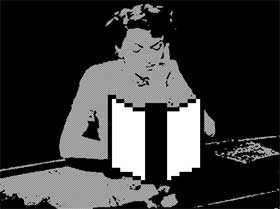



A spotlight appears on a screen to the left as a suited figure with Indian head dress steps into the frame, a clear reference to the iconic Bond opening sequences. Delayed by a few seconds, the right screen lights up as a second shooter strides across. The crack of gunshots sound as firearms on the left and right are drawn and triggered. The work, entitled Gunfight, is one of a series by Canadian artist Stephen Foster, currently showing at MIC.
What's interesting about the work is the tension deriving from the timing - it's not immediately clear who will shoot first. As writer Monika Gagnon elaborates, "The loops end, and replay endlessly, cowboy or Indian drawing first, depending on how the two digital videos align themselves to each other on each screening."
 Unfortunately I found Gunfight to be the strongest piece in the show. Foster employs a number of graphic techniques consistently, resulting in compositions of high-resolution digital objects with glowing effects and obvious scan lines. The resulting style Gagnon describes as "hyper-real", a fitting aesthetic in some ways for work which deals with posturing and power struggles, historical and contemporary authenticity. But while it's an apt commentary for it's subject, the staged aesthetic asphyxiates it's medium as well, leaving behind a series of artificially slick digital compositions which ultimately fail to move or compel.
Unfortunately I found Gunfight to be the strongest piece in the show. Foster employs a number of graphic techniques consistently, resulting in compositions of high-resolution digital objects with glowing effects and obvious scan lines. The resulting style Gagnon describes as "hyper-real", a fitting aesthetic in some ways for work which deals with posturing and power struggles, historical and contemporary authenticity. But while it's an apt commentary for it's subject, the staged aesthetic asphyxiates it's medium as well, leaving behind a series of artificially slick digital compositions which ultimately fail to move or compel.


















